

Contemporary-cottages_180315_09. Bla and BlaBla by Meneghello Paolelli Associati for Horm. Meneghello Paolelli Associati have designed Bla and BlaBla, a small armchair and sofa for manufacturer Horm.

Description Original design for a small armchair (BLA) and sofa (BLABLA). The name was chosen ironically to hint at chat or conversation.The flowing shapes of these light welcoming pieces are designed to occupy a room without crowding it, and almost seem to whisper to you in a sensuous way.Finishes: Structure in hardwood and composite, body in crushproof expanded polyurethane, feet in Canaletto walnut or shiny aluminium.Dimensions: 97 x 86 x 80H cm (Bla) and 193 x 86 x 80H cm (BlaBla) Un canapé convertible… en lits superposés !
//Slash sofa by Adrien Rovero for Campeggi. Milan 2010: Swiss designer Adrien Rovero has created a sofa that can be transformed into a bed by re-arranging blocks of upholstery.
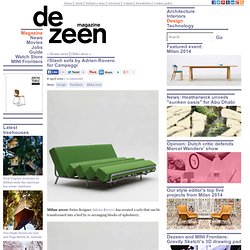
Called //Slash, the furniture will be presented by Italian brand Campeggi at the Salone Internazionale del Mobile next week. The tubular metal frame has slats supporting the foam blocks, and the two parts slide apart to expand into a bed. See all our stories about Milan 2010 in our special category. Kulle lumpy day bed with boiled-wool bobbles by Stefanie Schissler. Cologne 2014: this day bed by young designer Stefanie Schissler is intentionally lumpy to encourage users to snuggle into it.

The Kulle day bed by Stefanie Schissler has an undulating surface caused by the different sized pieces of upholstery foam concealed beneath its stretchy boiled-wool surface. The German designer wanted to create a piece of furniture for relaxation that invites the user to lay down through its appearance. "The look is something new, which is arising curiosity in people," Schissler told Dezeen. "It is designed to arise the urge to touch and feel it. " The small cubes of leftover foam used have different densities and heights so the squashiness varies across the surface. She added that the piece is not really meant for sitting on but as a landscape for relaxation.
Schissler graduates this year from Hochschule für Gestaltung Schwäbisch Gmünd in Germany, but developed this project during an exchange semester at Lund University in Sweden. Side table extends from base of Rise sofa by Note Design Studio. Stockholm 2014: the wooden base of this sofa by Swedish firm Note Design Studio extends outwards to become a side table.
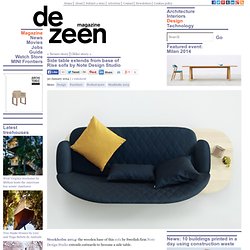
The low table was formed by continuing the ash wood platform out from one end of the sofa, which is part of Note's Rise collection designed for Swedish furniture brand Fogia. "The integrated side table becomes a bridge between the piece of furniture and the rest of the room," said the designers. "A surface for a still life, a favourite book, plants or whatever you choose to have close at hand. " Rounded soft cushions covered in quilted upholstery sit on top of the base. The collection is named Rise because the seat backs are shaped to resemble the sun coming up over the horizon. Note created the range for use in both domestic and commercial settings. Sofa based on a pin cushion by Demeter Fogarasi. Stockholm 2014: enormous dressmaker's pins seem to puncture the seat of this sofa by Hungarian design student Demeter Fogarasi, pushing through to form legs on the underside.
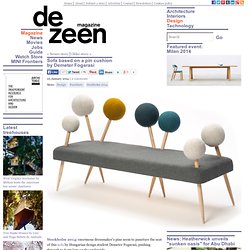
The Pinsofa by Demeter Fogarasi features wooden poles protruding at angles from the top and bottom of a plywood platform, which is upholstered with two layers of foam and covered with fabric donated by Danish firm Kvadrat. Large hand-upholstered spherical cushions top each rod to give the effect of giant pins stuck through the seat. Une méridienne et une sculpture contemporaine - Un loft parisien en pleine lumière. Prado sofa with movable backrests by Christian Werner for Ligne Roset. Cologne 2014: German designer Christian Werner has created a sofa for French brand Ligne Roset with backrests that can be placed in any position (+ slideshow).
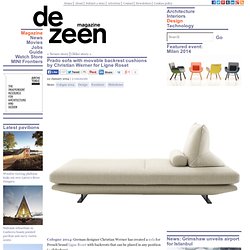
Werner designed the Prado sofa to allow users the freedom to configure the sofa to suit their mood or lifestyle. Weighted cushions that act as movable backrests and additional bolster cushions can be arranged in any configuration on top of the large seat, or used to create informal seating areas on the floor. From front-on the cushions have a standard oblong shape but sweep out at the back to form a stable base. Philippe Nigro designs curvaceous sofa for Ligne Roset. Cologne 2014: French designer Philippe Nigro has created a sofa for French furniture brand Ligne Roset with rounded edges like a bar of soap (+ slideshow).

Nigro's main aim with the design of the Cosse sofa for Ligne Roset was to optimise comfort, so he created a form with gentle contours that sweep around the sitter. The designer described the shape of the sofa as: "Softly welcoming contours, a soft, delicate all-enveloping form which, sustained by a fine natural wood structure, floats above the ground. " The seat features a curved front edge that transitions into undulating armrests and connects to the high, rounded backrest. Webbed elastic suspension adds to the comfort of the cushion.
"Mastery of the constraints of series production, hand in hand with optimized technology and materials, work together to produce freely-flowing shapes such as that of the Cosse settee," Nigro added. Racket Collection by Campana Brothers. Poppins by Alessandrabaldereschi Design Studio. Austerity edible furniture by Lanzavecchia + Wai. Milan 2013: a coffee table topped with a giant hard-boiled sweet and a white chocolate chair are among items in a series of edible furniture by design studio Lanzavecchia + Wai (+ slideshow).

Designed in response to the current economic climate, the decorative or unnecessary elements of the furniture can be eaten until all that's left is what's needed for basic functionality. Lanzavecchia + Wai used a range of food types to build up each item around its pared-down black iron version. Aunts and Uncles by Philippe Starck for Kartell. Milan 2013: according to manufacturers Kartell, French designer Philippe Starck has used the world's largest single-piece injection moulding to create this family of furniture shown in Milan this week.
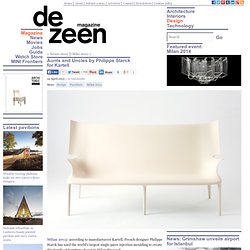
Philippe Starck cites nostalgia and sentimentality as his main influences for the collection: "My family of Kartell 'uncles and aunts' is the minimalist technological version of the armchairs and sofas where my uncles and aunts used to sit smoking their pipes or knitting by the fireplace in total peace and serenity. " "Times have changed and so has furniture, but our dreams are always the same," he adds. Each member of the Aunts and Uncles series, for Italian brand Kartell, is made of polycarbonate and has been created using single-mould injection technology. Concentré de Vie modular sofa by Matali Crasset for Campeggi. Milan 2013: French designer Matali Crasset has designed a sofa that breaks down into a bed, two armchairs and two footstools.
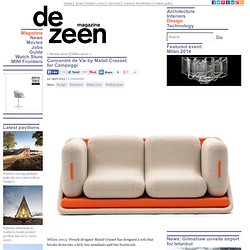
Called Concentré de Vie, the system by Matali Crasset comprises two upholstered chairs and two pebble-like cushions, housed in a triangular base that doubles as a single bed. The elements are upholstered in neutral fabric with orange highlights and can be rearranged to accommodate different numbers of guests or activities as required. Italian brand Campeggi showed the design at Salone Internazionale del Mobile in Milan. Hamper sofa by Riva and Montanelli for Passoni Nature. "Watch out" for furniture industry's unfair contracts and royalties.
Young German designer Hanna Emelie Ernsting is producing her latest furniture collection herself following a "really tough" experience with a major brand, and has warned fellow designers to "watch out" for unfair contracts (+ interview). Ernsting has launched her range of Petstools under her own name, two years after signing a contract to manufacture her graduation projects with a brand that then failed to produce them. "I couldn't get out of the contract," she said. "So I couldn't use my designs even though they would not produce them. " Seating made from corrugated tube. Toward Sofa by Anne Boysen for Erik Jørgensen. Serac Bench by Zaha Hadid for LAB 23. Seating Stones by UNStudio. Product news: these triangular sofas by Dutch architects UNStudio were inspired by geological formations. Created for furniture manufacturers Walter Knoll, the seats tesselate to form clusters that break up communal spaces like lobbies and lounges.
They are made of Polyurethane foam on a steel frame and can be upholstered in a variety of colour combinations that are meant to reference a collection of precious stones. "The Seating Stones are designed to generate numerous different atmospheres, which is why we included a wide variety of possible configurations and colours but also a selection of materials," co-founder of UNStudio Ben van Berkel told Dezeen. "We also created something that wasn’t instantly recognisable as a chair and that in fact was somewhat more sculptural as a form. " UNStudio are launching the sofa design this week at Orgatec in Cologne, which continues until 27 October. You can read more stories about UNStudio here» See all our stories about seating»